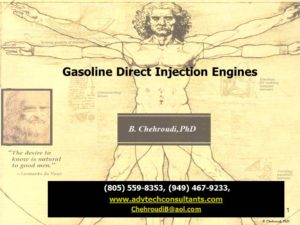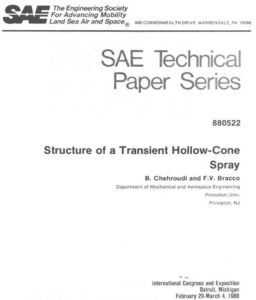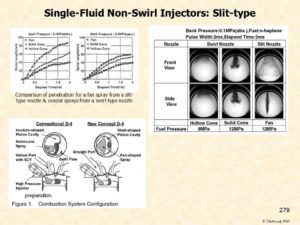The quest for an even more efficient, smarter, and environmentally-cleaner liquid-fueled spark ignition (SI) reciprocating engine than the current multi-port fuel injection (MPFI) SI engines is more alive and intense now than ever before. In this effort the GDI SI engines have an important and special place. Some background information is of value to facilitate the understanding of the operation and potentials of the GDI engines. The history of the fuel/air mixture preparation system in SI engines starts with the carburetor units positioned in the intake system just prior to the throttle valve which itself is connected to the driver accelerator foot-pedal for manual load (or engine output torque and power) changes in these engines. For many years this served the purpose until the race for the higher performance, more fuel efficient, and cleaner-burn engine intensified that led to the MPFI SI engine design. In this design, an electronically-controlled fuel injector is used per each cylinder for fuel metering and targeting of the sprays towards the intake valves. In MPFI engines the amount of fuel injected can be independently controlled from the air flow and the replacement of the carburetor unit by the port injectors itself caused a better breathing capability (or higher so-called volumetric efficiency) of the engine leading to higher output torque and power levels. Higher volumetric efficiency means that each cylinder of the engine can bring more mass of air thereby providing the potential and opportunity for more fuel introduction and hence higher chemical energy release per cycle delivering a higher engine torque. In contrast, diesel engines use direct liquid fuel injection into the cylinder and rely on autoignition of the fuel itself with no external ignition sources such as spark plug or any other means. The load in these engines are varied by changes in the amount of the fuel injected and there are no throttle valves in the intake system. Therefore, the pumping work, a negative work or energy needed to pump air in and burned gases out of the cylinders, are nearly zero for diesel engines whereas it changes from a maximum value, at idle throttle valve position, to a negligible amount under full load at wide open throttle (WOT) valve position in SI engines. Note that the net indicated output work of an engine is equal to the total work during the compression and expansion strokes minus the pumping work. Pumping work is also referred to as throttling work losses in the automotive literatures. The absence of the throttling work losses (as a result of the lack of the throttle valve) for the direct injection (DI) diesel engine is also one significant advantage of the GDI engine design. This provides an opportunity for improvement in specific fuel consumption (SFC) over the current MPFI engines. In a sense a GDI engine is like a DI diesel engine but with a suitably-positioned spark plug and a gasoline fuel, instead of the easily auto-igniting diesel fuel, in-cylinder injection system. In practice, some degree of throttle control is usually required for GDI engines, compromising the SFC improvement potential.
operation and potentials of the GDI engines. The history of the fuel/air mixture preparation system in SI engines starts with the carburetor units positioned in the intake system just prior to the throttle valve which itself is connected to the driver accelerator foot-pedal for manual load (or engine output torque and power) changes in these engines. For many years this served the purpose until the race for the higher performance, more fuel efficient, and cleaner-burn engine intensified that led to the MPFI SI engine design. In this design, an electronically-controlled fuel injector is used per each cylinder for fuel metering and targeting of the sprays towards the intake valves. In MPFI engines the amount of fuel injected can be independently controlled from the air flow and the replacement of the carburetor unit by the port injectors itself caused a better breathing capability (or higher so-called volumetric efficiency) of the engine leading to higher output torque and power levels. Higher volumetric efficiency means that each cylinder of the engine can bring more mass of air thereby providing the potential and opportunity for more fuel introduction and hence higher chemical energy release per cycle delivering a higher engine torque. In contrast, diesel engines use direct liquid fuel injection into the cylinder and rely on autoignition of the fuel itself with no external ignition sources such as spark plug or any other means. The load in these engines are varied by changes in the amount of the fuel injected and there are no throttle valves in the intake system. Therefore, the pumping work, a negative work or energy needed to pump air in and burned gases out of the cylinders, are nearly zero for diesel engines whereas it changes from a maximum value, at idle throttle valve position, to a negligible amount under full load at wide open throttle (WOT) valve position in SI engines. Note that the net indicated output work of an engine is equal to the total work during the compression and expansion strokes minus the pumping work. Pumping work is also referred to as throttling work losses in the automotive literatures. The absence of the throttling work losses (as a result of the lack of the throttle valve) for the direct injection (DI) diesel engine is also one significant advantage of the GDI engine design. This provides an opportunity for improvement in specific fuel consumption (SFC) over the current MPFI engines. In a sense a GDI engine is like a DI diesel engine but with a suitably-positioned spark plug and a gasoline fuel, instead of the easily auto-igniting diesel fuel, in-cylinder injection system. In practice, some degree of throttle control is usually required for GDI engines, compromising the SFC improvement potential.
Full potential of the GDI engine can be harnessed if ...
Learning Objectives:
Upon completion of this seminar, you will be able to:
- Describe the rationale behind the GDI engine operation
- Analyze the important processes in GDI engines
- Explain liquid atomization, sprays, and injector requirements for successful GDI operation
- Utilize the technology and the logic behind gasoline direct injection
- Estimate and predict effects of key engine design and operating conditions on performance, combustion, and emission in GDI engines
- Communicate effectively with engineers working on fuel injection, combustion and emission aspects of the GDI engine in your firm or with customers
- Effectively contribute to the design of critical components such as combustion chambers, injectors, and emission reduction strategies
- Explain and utilize trade-offs between increasing engine performance and maintaining low emission characteristics
Who Should Attend:
This seminar will be especially valuable for engineers, technical and project managers, researchers, and academicians. Engineers working on the design of components for high efficiency and performance of GDI engines as well as those directly and indirectly involved in mixture preparation and emission reduction of harmful pollutants from these engines will highly benefit from this course. Environmental engineers desiring to expand their understanding of fuel spray formation, combustion and emissions from GDI engines will benefit, as well as, engineers active in the development and application of software for the modeling and design of combustion chambers, fuel spray dynamics, combustion and emission issues.
How to Arrange for a Presentation:
Due to ATC's low overhead, direct-contact clients are offered a competitive and cost-effective package. Individuals interested in these seminars should contact Advanced Technology Consultants (ATC) directly. Alternatively, this seminar (prepared by the ATC and delivered by a award-winning ATC consultant) is also sponsored by the Society of Automotive Engineers (www.SAE.org). Click here at GDI to see the SAE page for this seminar.
Electronic and hard copies of the seminar materials can be purchased and are only available through ATC. Contact ATC for price and shipping.
NOTE: Professionally-prepared "audio-video Powerpoint-type presentations" of these seminars are available for purchase by companies. Each slide is presented with a clear audio by the consultant, describing the subject, while a digital pointer guides the audience to where the attention is to be focused. Companies can put such audio-video presentations on their intranet to be used by their employees. It is a cost effective way of approaching professional training, which also contributes towards R&D, design, and intelligent new product development efforts. Presentations are updated every year at a fraction of the original cost. For a sample presentation click on the word "INJECTION" in the picture to get a feel of how information is transferred (High-speed internet access is recommended. Otherwise, download may take a few more minutes). For more details and pricing please contact ATC.
List of topics discussed in the seminar:
- Liquid atomization, sprays, and fuel injection are prevalent
- Combustion Systems

- Relative position of spark plug and fuel injector
- How to achieve homogeneous and stratified charge -- spray-, wall-, and air-guided combustion systems
- Fuel Injection System
- Fuel injection system requirements
- Fuel injector requirements and classification
- Fuel Spray Characteristics
- Spray atomization requirements
- Sac spray consideration
- After-injection
- Fuel spray penetration and cone angle
- Split injection
- Sprays characteristics of injectors
- Effects of ambient pressure (density) on spray
- Spray characterization (GDI)
- Mixture Formation
- In-cylinder flow characteristics and GDI combustion
- Fuel-air mixing process
- Spray-wall interactions
- Cold start and wall wetting issues
- Combustion Process and Control Strategies

- Engine Operating Modes and Fuel Injection Strategies
- Early-injection, late-injection, stoichiometric operation
- Operating mode transition
- Split Injection Strategy
- Two-stage, split, and post injection
- Combustion characteristics
- Homogeneous-charge and stratified-charge combustion
- Effects of Engine Operating and Design Parameters on GDI Combustion
- Injection and ignition timings
- Spray cone angle
- EGR
- Knock resistance characteristics
- Air-assisted versus single-fluid GDI fuel system
- Injector, Combustion Chamber, and Intake Valve Deposits
- Emissions of Pollutants - Reduction Approaches
- Hydrocarbon, NOx and particulate
- Fuel Economy
- Factors affecting improved fuel economy
- Fuel economy versus emissions compromise
- Select Gasoline Direct-Injection Engines
- Early DISC engine
- Mitsubishi reverse-tumble-based wall-guided

- Concise review of Toyota, Nissan swirl-based (wall-guided), Audi wall-guided, AVL, FEV air-guided, Ford, Honda spray-guided, Isuzu, Mazda swirl-based, wall-guided, Mercedes-Benz spray-guided, Ricardo tumble-based, wall-guided, Volkswagen tumble-based, wall-guided FSI
- Benefits of Turbocharging a GDI engine
Testimonial:
"It covers every possible attendee, from the one that wants only an overview to the one that needs the most deep detail of GDI engine. Worth the trip I made from Greece. "
Savvas Savvakis, PhD - Researcher
Aristotle University of Thessaloniki
